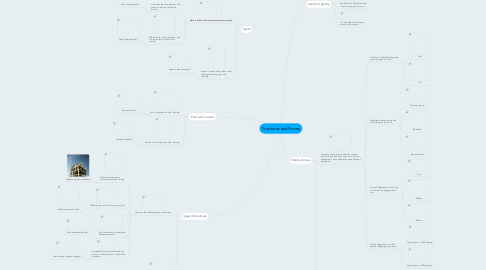
1. Types of structures
1.1. There are four different types of structures:
1.1.1. Skeleton structures are structures that uses a frame.
1.1.1.1. Skeleton structure example 2
1.1.2. Shell structures are hollow and very light.
1.1.2.1. Shell structure example 2
1.1.3. Solid structures are usually the heaviest structures.
1.1.3.1. Solid structure example 2
1.1.4. Combination structures are made of a mixture of solid, skeleton, and/or shell structures.
1.1.4.1. Combination structure example 2
1.2. Structure example 2
2. Form and function
2.1. Form is the shape of the structure.
2.1.1. Form example 2
2.2. Function is the purpose of the structure.
2.2.1. Function example 2
3. loads
3.1. Static loads are loads that are caused by gravity.
3.1.1. Live loads are the objects on the structure, and are caused by gravity.
3.1.1.1. Live loads example 2
3.1.2. The structure is the dead load, and is also caused by the force of gravity.
3.1.2.1. Dead load example 2
3.2. Dynamic loads are the forces (other than gravity) acting upon the structure.
3.2.1. Dynamic loads example 2
4. External forces
4.1. External forces are forces that can "create" internal forces, and have a specific Direction, Magnitude, Point of Application and Plane of Application
4.1.1. Direction is whether the applying force is a push or a pull.
4.1.1.1. Push
4.1.1.2. Pull
4.1.2. Magnitude is how strong and fast the applying force is.
4.1.2.1. Fast and strong
4.1.2.2. Moderate
4.1.2.3. Slow and weak
4.1.3. Point of Application is how high or how low the applying force hits.
4.1.3.1. Top
4.1.3.2. Middle
4.1.3.3. Bottom
4.1.4. Plane of Application is what degree the applying force hits.
4.1.4.1. Car hitting car at 180 degrees.
4.1.4.2. Car hitting car at 90 degrees.
